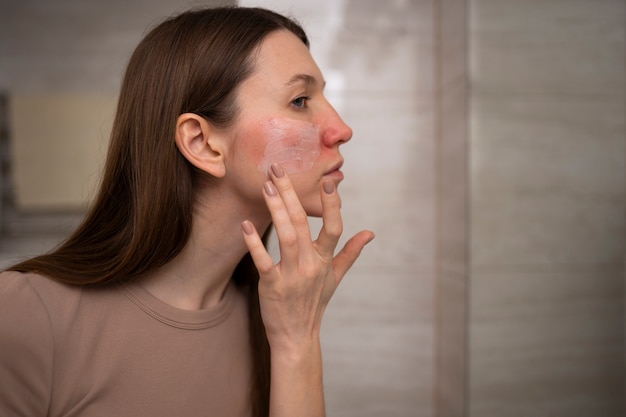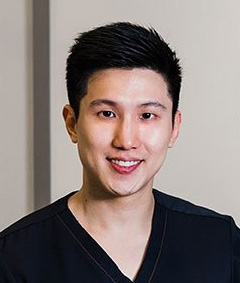Rosacea and acne are two prevalent skin conditions that often lead to confusion due to their similar appearance. Both conditions manifest as red, inflamed skin and can significantly affect one’s self-esteem and quality of life. However, despite their outward similarities, the two acne-like breakouts are distinct conditions with different causes, symptoms, and treatments.
In this blog, Dr. Justin Boey, Medical Director of Sozo Aesthetic Clinic, will share insights from his understanding of these differences, which are crucial for the effective management and care of common skin diseases.
Contents
What is Rosacea?
Rosacea is a chronic skin condition primarily affecting the face, characterised by redness, visible blood vessels, and small red bumps filled with pus. It most commonly begins any time after 30 years of age and tends to worsen with time if left untreated. Unlike acne, which is often linked to hormonal variations and can begin in adolescence, rosacea’s onset is typically in adulthood, making it a particularly challenging condition for many adults who may not expect to encounter new skin issues at this stage.
The exact cause of rosacea remains unknown, although a combination of hereditary and environmental factors is believed to contribute to its development. Triggers such as sunlight, stress, spicy foods, alcohol, and certain skincare products can exacerbate symptoms. Additionally, individuals with fair skin and a family history of rosacea are at a higher risk of developing the condition. Understanding these factors and potential triggers is crucial for managing rosacea effectively and minimising flare-ups.
What is Acne?
Acne is a widespread skin condition that can affect individuals at any age, though it is most commonly associated with adolescence and the hormonal changes that occur during puberty. The appearance of spots and blackheads characterises this condition, and sometimes painful cysts or nodules, primarily on the face, back, and chest. The primary cause of acne is excess oil production by the skin’s sebaceous glands, combined with dead skin cells, leading to clogged pores.
The presence of a particular type of bacteria, Propionibacterium acnes (P. acnes), can exacerbate the situation, leading to inflamed and infected spots. Additional factors contributing to acne include hormonal imbalances, diet, stress levels, and certain acne medications. Unlike rosacea, acne’s roots largely lie in the overproduction of oil and the blockage of pores, reflecting a different pathophysiology that requires varied approaches for treatment and management.
Key Differences Between Rosacea and Acne

Understanding the nuances between rosacea and acne is pivotal for their effective management. At their core, acne rosacea is characterised by chronic facial redness and visible blood vessels, typically emerging in adulthood, without clear causation but with potential hereditary and environmental influences. In contrast, acne revolves around the overproduction of oil and clogged pores and can strike at any age, often driven by hormonal changes, particularly during adolescence. Despite their superficial similarities, the differences in onset, symptoms, causes, and acne treatments underline the importance of accurate diagnosis and tailored approaches for each condition.
Breakout Types
The distinctions in breakout types between rosacea and acne are significant and serve as a key identifier for each condition. In individuals with acne rosacea, breakouts typically manifest as small, red, pus-filled bumps that can be mistaken for acne. However, unlike acne, these abscesses are often sterile and do not contain the same type of bacteria. Furthermore, acne rosacea is less likely to feature blackheads and whiteheads, which are hallmarks of acne.
In contrast, acne is characterised by a wider variety of lesions, including blackheads (open comedones), whiteheads (closed comedones), and pus-filled pimples that are often bacterial. This fundamental difference in breakout types is crucial for proper diagnosis and subsequent treatment, highlighting the need for specialised care tailored to each condition.
Location
The location of the breakouts is a distinguishing factor between acne rosacea and acne. Rosacea primarily affects the central parts of the face, including the cheeks, nose, forehead, and chin. This concentration of symptoms in the facial region underscores rosacea’s profound impact on individuals’ appearance and, consequently, their self-esteem.
On the other hand, acne is not confined to the face alone; it can manifest on various parts of the body, notably the back, chest, shoulders, and face. This difference in breakout locations further assists in the differentiation between the two conditions, highlighting the importance of observing not just the type of skin lesions presented but also their distribution across the body.
Understanding these distinct patterns of breakouts aids in accurate diagnosis and tailored treatment plans for individuals dealing with these skin conditions. By paying attention to where the breakouts occur, healthcare professionals can provide more effective care and support to those affected by acne rosacea and acne.
Triggers
Understanding the triggers of acne rosacea and acne vulgaris is essential for managing both conditions effectively. Rosacea triggers are widely associated with factors that lead to vasodilation and increased inflammation. Common triggers include hot drinks, spicy foods, alcohol, extreme temperatures, sunlight exposure, stress, and certain cosmetics. These factors can exacerbate the redness and visible blood vessels characteristic of rosacea by increasing blood flow to the skin’s surface.
Conversely, acne triggers often relate to hormonal fluctuations, excessive production of oil (sebum), and the presence of bacteria on the skin. Hormonal changes, particularly during puberty, menstruation, pregnancy, and certain health conditions, can significantly impact sebum production. Additionally, using oily or comedogenic skincare and makeup products can clog pores, promoting the formation of acne lesions. Stress and dietary factors, particularly foods with a high glycaemic index, have also been linked to acne flare-ups. Propionibacterium acnes plays a crucial role in acne, as it can lead to inflammation and the formation of pus-filled lesions when it proliferates within clogged pores.
Age of onset
A significant difference between rosacea and acne is their typical age of onset. Rosacea often affects adults over 30, challenging the misconception that skin issues are exclusive to younger individuals. On the other hand, acne vulgaris primarily targets teenagers and young adults, though it can persist into adulthood for some. This divergence highlights the importance of considering age and life stage in diagnosing and managing these conditions effectively. Tailoring treatments to address the specific needs and concerns of individuals at different stages of life ensures optimal outcomes and improved quality of life. By understanding these distinctions, aestheticians can provide comprehensive care that addresses the unique challenges posed by rosacea and acne across various age groups.
Other features
When telling rosacea and acne vulgaris apart, look at other signs and feelings that come with each. Rosacea often causes flushing and quick, persistent redness triggered by hot drinks or stress. You might see red blood vessels, known as telangiectasia, adding to the redness. Some people feel burning or stinging on the skin affected by rosacea. Besides rosacea skin problems, rosacea can affect the eyes (ocular rosacea), causing dry, irritated, and puffy eyes and eyelids, which can be uncomfortable and affect eye health.
On the other hand, acne vulgaris is linked to oily skin, which can cause acne breakouts by trapping bacteria and dead skin cells in pores. Severe acne, like cystic acne, can lead to lasting scars. Inflammation and deep breakouts from severe acne can harm the skin, possibly causing pitted or depressed areas and sometimes raised keloid scars.
The feature of flushing and notable blood vessels in rosacea patients and the oiliness and potential scarring associated with acne are key distinguishing factors that further underscore the necessity for accurate diagnosis and appropriate treatment plans tailored to each condition’s specific needs and challenges.
Diagnosis and Treatment

Skin conditions like both acne and rosacea can be complex, so getting an accurate diagnosis from a skincare professional is crucial. At Sozo Clinic, our aestheticians are experts at identifying and treating these conditions with personalised care.
Treatment options at Sozo Clinic vary widely, ranging from topical medications and oral antibiotics aimed at reducing inflammation and controlling skin bacteria to advanced therapies such as laser treatments for severe rosacea flare-ups or acne scarring cases. In addition to medical interventions, our aestheticians emphasise identifying and managing triggers that may exacerbate each condition. This holistic approach ensures acne treatment is not just symptomatic relief but also works towards achieving long-term skin health.
Equally important is the establishment and maintenance of a consistent skincare routine. The doctors at Sozo Clinic guide patients in selecting the right products that are gentle on sensitive skin, non-comedogenic, and supportive of the skin’s natural barrier. This personalised guidance is key in managing rosacea and acne vulgaris effectively, underpinning the clinic’s commitment to treating skin conditions and empowering individuals to maintain their skin health with confidence and knowledge.
Conclusion
Dealing with rosacea and acne can be tough. Professional guidance is key in understanding and handling these conditions effectively. If you’re experiencing symptoms that align with either condition, it’s crucial to consult with an aesthetician. These trained professionals possess the expertise necessary to provide an accurate diagnosis and develop a treatment plan tailored to your unique needs. Following an aesthetician-recommended skincare regimen is vital, not only for managing symptoms but also for safeguarding your overall skin health.
Remember, each individual’s skin is unique; what works for one person might not work for another. Seeking expert advice ensures you receive personalised care designed to offer relief and improve your quality of life. Trust professional guidance and take the first step towards understanding and effectively managing your skin condition.





